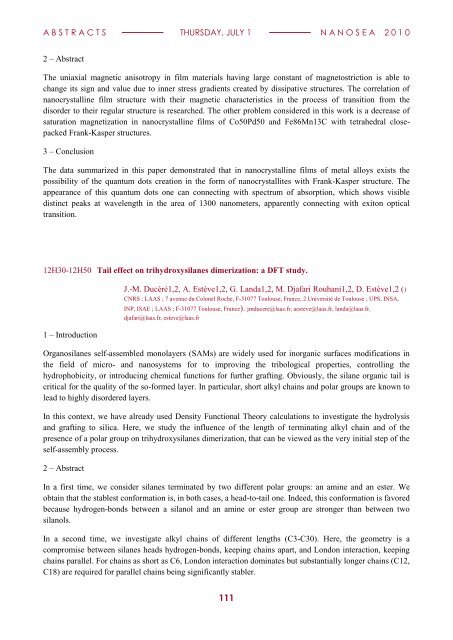book of abstracts - IM2NP
book of abstracts - IM2NP
book of abstracts - IM2NP
Create successful ePaper yourself
Turn your PDF publications into a flip-book with our unique Google optimized e-Paper software.
A B S T R A C T S THURSDAY, JULY 1 N A N O S E A 2 0 1 0<br />
2 – Abstract<br />
The uniaxial magnetic anisotropy in film materials having large constant <strong>of</strong> magnetostriction is able to<br />
change its sign and value due to inner stress gradients created by dissipative structures. The correlation <strong>of</strong><br />
nanocrystalline film structure with their magnetic characteristics in the process <strong>of</strong> transition from the<br />
disorder to their regular structure is researched. The other problem considered in this work is a decrease <strong>of</strong><br />
saturation magnetization in nanocrystalline films <strong>of</strong> Co50Pd50 and Fe86Mn13C with tetrahedral closepacked<br />
Frank-Kasper structures.<br />
3 – Conclusion<br />
The data summarized in this paper demonstrated that in nanocrystalline films <strong>of</strong> metal alloys exists the<br />
possibility <strong>of</strong> the quantum dots creation in the form <strong>of</strong> nanocrystallites with Frank-Kasper structure. The<br />
appearance <strong>of</strong> this quantum dots one can connecting with spectrum <strong>of</strong> absorption, which shows visible<br />
distinct peaks at wavelength in the area <strong>of</strong> 1300 nanometers, apparently connecting with exiton optical<br />
transition.<br />
12H30-12H50 Tail effect on trihydroxysilanes dimerization: a DFT study.<br />
1 – Introduction<br />
J.-M. Ducéré1,2, A. Estève1,2, G. Landa1,2, M. Djafari Rouhani1,2, D. Estève1,2 (1<br />
CNRS ; LAAS ; 7 avenue du Colonel Roche, F-31077 Toulouse, France, 2 Université de Toulouse ; UPS, INSA,<br />
INP, ISAE ; LAAS ; F-31077 Toulouse, France). jmducere@laas.fr, aesteve@laas.fr, landa@laas.fr,<br />
djafari@laas.fr, esteve@laas.fr<br />
Organosilanes self-assembled monolayers (SAMs) are widely used for inorganic surfaces modifications in<br />
the field <strong>of</strong> micro- and nanosystems for to improving the tribological properties, controlling the<br />
hydrophobicity, or introducing chemical functions for further grafting. Obviously, the silane organic tail is<br />
critical for the quality <strong>of</strong> the so-formed layer. In particular, short alkyl chains and polar groups are known to<br />
lead to highly disordered layers.<br />
In this context, we have already used Density Functional Theory calculations to investigate the hydrolysis<br />
and grafting to silica. Here, we study the influence <strong>of</strong> the length <strong>of</strong> terminating alkyl chain and <strong>of</strong> the<br />
presence <strong>of</strong> a polar group on trihydroxysilanes dimerization, that can be viewed as the very initial step <strong>of</strong> the<br />
self-assembly process.<br />
2 – Abstract<br />
In a first time, we consider silanes terminated by two different polar groups: an amine and an ester. We<br />
obtain that the stablest conformation is, in both cases, a head-to-tail one. Indeed, this conformation is favored<br />
because hydrogen-bonds between a silanol and an amine or ester group are stronger than between two<br />
silanols.<br />
In a second time, we investigate alkyl chains <strong>of</strong> different lengths (C3-C30). Here, the geometry is a<br />
compromise between silanes heads hydrogen-bonds, keeping chains apart, and London interaction, keeping<br />
chains parallel. For chains as short as C6, London interaction dominates but substantially longer chains (C12,<br />
C18) are required for parallel chains being significantly stabler.<br />
111

















